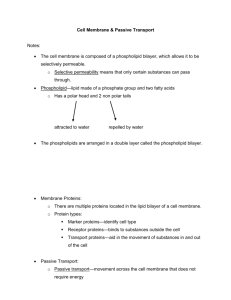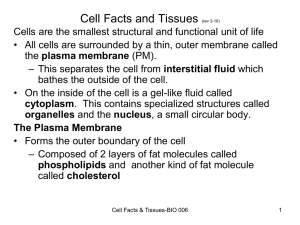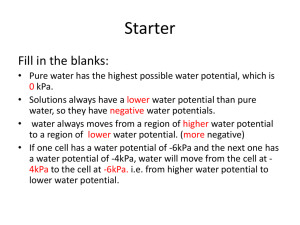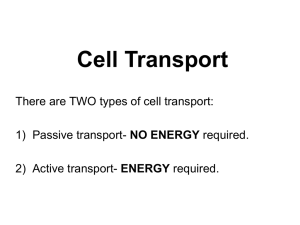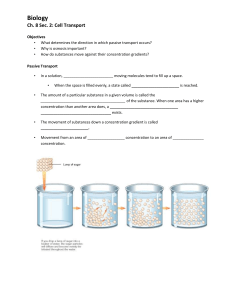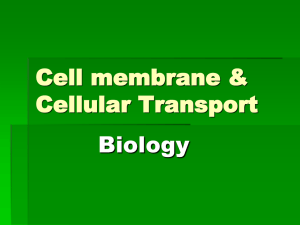Biology
advertisement
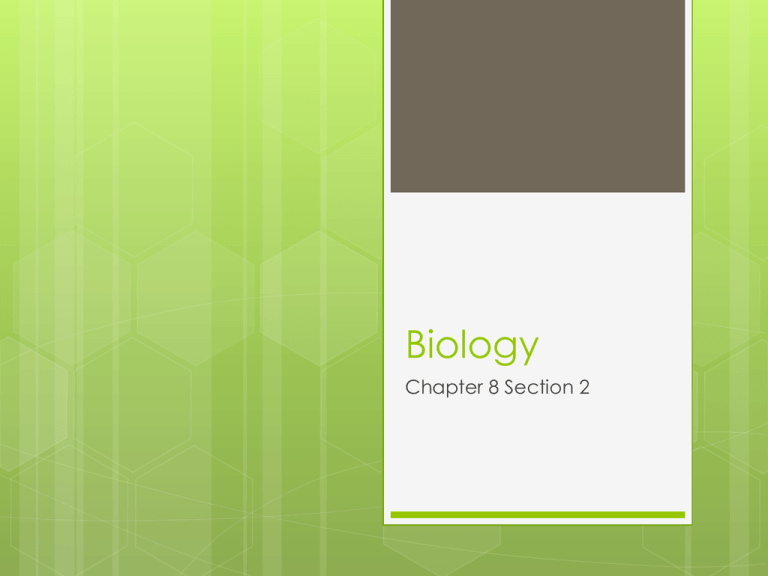
Biology Chapter 8 Section 2 Key Ideas What determines the direction in which passive transport occurs? Why is osmosis important? How do substances move against their concentration gradients? What’s the difference between active and passive transport? In active transport, the cell is required to use energy to move a substance. In passive transport, the cell does not use energy. Passive Transport When a space is filled evenly, a state called equilibrium is reached. The amount of a particular substance in a given volume is called the concentration of the substance. When one area has a higher concentration than another area does, a concentration gradient exists. Substances move from an area of higher concentration to an area of lower concentration. This movement down the concentration gradient is called diffusion. Some substances enter and leave the cell by diffusion across the cell membrane. In passive transport, substances cross the cell membrane down their concentration gradient. Simple Diffusion Occurs when small, nonpolar molecules can pass directly through the lipid bilayer. Oxygen diffuses into the cell through the lipid bilayer. The concentration of oxygen is higher outside the cell than it is inside. Oxygen moves DOWN the concentration gradient. Carbon dioxide is often higher inside the cell than it is outside. So carbon dioxide diffuses out of the cell. Facilitated Diffusion Many ions and polar molecules do not diffuse easily through the nonpolar lipid bilayer. During facilitated diffusion, transport proteins help these substances diffuse through the cell membrane. Two types of transport proteins are channel proteins and carrier proteins. Channel Proteins Ions, sugars, and amino acids can diffuse through the cell membrane through channel proteins. They serve are tunnels through the lipid bilayer. Each channel allows for the diffusion of specific substances that have the right size and charge. Example: only sodium ions can pass through the sodium ion channel. Carrier Proteins Carrier proteins transport substances that fit within their binding site. A carrier protein binds to a specific substance on one side of the cell membrane. This binding causes the protein to change shape. As the protein’s shape changes, the substance is moved across the membrane and is released on the other side. Osmosis Water can diffuse across a selectively permeable membrane in a process called osmosis. It’s a type of passive transport. Allows cells to maintain water balance as their environment changes. Polar water molecules do not diffuse directly through the bilayer. The cell membrane contains channel proteins that only water molecules can pass through. It is a form of facilitated diffusion. Predicting Water Movement Water moves out: if the solution is hypertonic, water moves out of the cell. The cell loses water and shrinks. Water moves in: if the solution is hypotonic, water moves into the cell. The cell gains water and expands in size. No net change in water movement: if the solution is isotonic, water diffuses into and out of the cell at equal rates. The cell stays the same size. Osmosis Effects of Osmosis If left unchecked, the swelling caused by a hypotonic solution could cause a cell to burst. Rigid cell walls of plants and fungi prevent the cells from expanding too much. Many plants are healthiest in a hypotonic state. Some unicellular eukaryotes have contractile vacuoles, which collect excess water inside the cell land force the water out of the cell. Animal cells have neither cell walls nor contractile vacuoles. But most animal cells can avoid swelling caused by osmosis by actively removing solutes from the cytoplasm. Active Transport Sometimes cells must transport substances against their concentration gradients. This is called active transport because the cells must use energy to move these substances. The energy needed for active transport is supplied by ATP. Pumps Many active transport processes use carrier proteins to move substances. The carrier proteins require energy to “pump” substances against their concentration gradient. Sodium-potassium pump http://highered.mcgraw- hill.com/sites/0072495855/student_view0/ chapter2/animation__how_the_sodium_p otassium_pump_works.html Page 182 diagram Endocytosis & Exocytosis Many substances are too large to be transported by carrier proteins. Instead, they move across the cell membrane in vesicles. http://www.youtube.com/watch?v=4gLtk 8Yc1Zc



